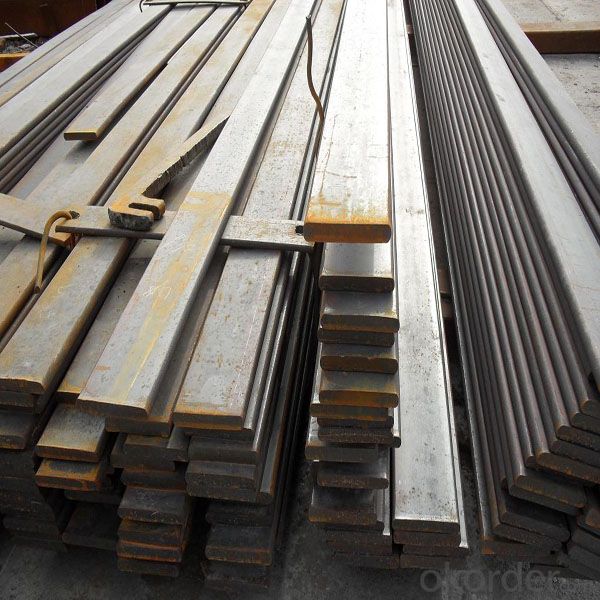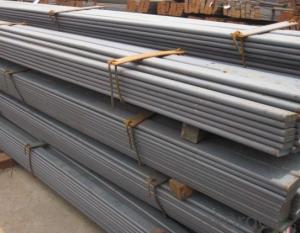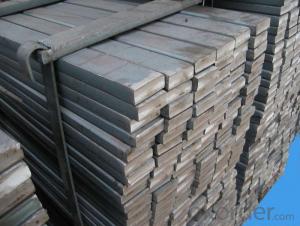Spring Steel Flat Bar ASTM Standard China Supplier
- Loading Port:
- Tianjin
- Payment Terms:
- TT OR LC
- Min Order Qty:
- 2000 PCS
- Supply Capability:
- 40000 PCS/month
OKorder Service Pledge
OKorder Financial Service
You Might Also Like
China Supplier ASTM Spring Steel Flat Bar Details
| Standard: | JIS,AISI,GB,DIN,EN,JIS, AISI, ASTM, GB ect | Dimensions: | 3mm-20mm | Grade: | 300 Series |
| Place of Origin: | China (Mainland) | Width: | 15mm-200mm | Model Number: | 321 304 304l 316 316l 321 |
| Type: | Flat | Application: | Boiler heat exchanger,machinery and hardware fields ect | Shape: | Square |
| Certification: | BV | Special Use: | Valve Steels | Material: | 304 316 317L 321 310S 430 904L ect |
| Surface: | 2B 8K HL NO.1 BA ect | Length: | 2000mm-6000mm | Quality: | Excellent and high quality control |
Packaging & Delivery
| Packaging Detail: | Standard seaworthy packing or as per your requirement |
| Delivery Detail: | About 3-5 days |
Features of China Supplier ASTM Spring Steel Flat Bar
The appearance of cold-rolled products gloss is good, beautiful;
Excellent high temperature strength;
Excellent work-hardening (after processing weakly magnetic)
Non-magnetic state solution
Specifications of China Supplier ASTM Spring Steel Flat Bar
1. Standard: GB ASTM, JIS etc
2. Grade: 304 316 317 321 430 904L ect
3. Size: 19*3 mm-140*12 mm
4. Thickness: 2mm-20mm
5. Width: 15m-200mm
6. Shape Manufactured: Flat bar
7. Length: 2m-6m or as customers' request
8. Surface finish: Black & Pickled & Bright
9. Manufacture technology: Cold drawn/cold rolled/hot rolled
China Supplier ASTM Spring Steel Flat Bar Pictures



- Q:How do steel sheets perform in terms of vibration damping?
- Steel sheets have good vibration damping properties due to their high density and stiffness. They are effective in reducing vibrations and minimizing noise transmission, making them suitable for various applications requiring vibration control and noise reduction.
- Q:What factors affect the cost of steel sheets?
- Several factors affect the cost of steel sheets, including the current market demand and supply, raw material prices, manufacturing and processing costs, transportation and logistics expenses, as well as any applicable trade tariffs or taxes. Additionally, factors such as the type and quality of steel, size and thickness of the sheets, as well as any special finishes or coatings required, can also impact the overall cost.
- Q:Are the steel sheets recyclable?
- Yes, steel sheets are recyclable. Steel is one of the most commonly recycled materials worldwide due to its high recycling rate and ease of processing. When steel sheets reach the end of their useful life, they can be collected, sorted, and sent to recycling facilities where they are melted down and transformed into new steel products. Recycling steel sheets not only helps conserve natural resources and reduce energy consumption but also helps reduce waste and minimize environmental impact.
- Q:What is the recommended storage method for the steel sheets?
- The recommended storage method for steel sheets is to keep them in a dry and well-ventilated area, preferably indoors, to prevent moisture and rust formation. It is also important to store them flat and adequately supported to avoid bending or warping.
- Q:What is the difference between a hot rolled and pickled steel sheet?
- The production of a hot rolled steel sheet involves heating the steel above its recrystallization temperature, typically around 1700°F (926°C), and then rolling it into the desired shape or thickness. This process leads to the formation of a scale or oxide layer on the surface of the steel. In contrast, a pickled steel sheet goes through an additional step known as pickling, which removes the scale or oxide layer formed during the hot rolling process. This step is usually carried out by immersing the steel sheet in an acid bath, such as hydrochloric acid, to dissolve the scale. The main distinction between a hot rolled and pickled steel sheet lies in the surface finish and cleanliness. Due to the presence of scale, a hot rolled steel sheet will have a rougher surface, which may not be visually appealing and might require further processing or finishing. On the other hand, a pickled steel sheet will exhibit a smoother and cleaner surface as a result of the scale removal. Another difference lies in the corrosion resistance of the two types of steel sheets. Hot rolled steel, with its scale, is more prone to corrosion, especially in humid or corrosive environments. Conversely, pickled steel possesses better corrosion resistance due to the elimination of the scale and the subsequent application of a protective coating or treatment. Regarding applications, hot rolled steel sheets are commonly used in structural components, construction materials, and general fabrication where surface finish is not a critical factor. In contrast, pickled steel sheets are often preferred in industries such as automotive, appliances, and manufacturing, where a smooth and clean surface is desired for further processing or finishing. In summary, the difference between a hot rolled and pickled steel sheet lies in the surface finish, cleanliness, and corrosion resistance. While hot rolled steel has a rougher surface due to the presence of scale, pickled steel undergoes an acid bath to remove the scale, resulting in a smoother and cleaner surface. Pickled steel also offers better resistance to corrosion and is preferred in applications where a high-quality surface finish is required.
- Q:Can steel sheets be used for structural applications?
- Yes, steel sheets can be used for structural applications. Steel sheets are commonly used in construction and engineering projects due to their strength, durability, and versatility. They can be fabricated into various shapes and sizes to suit different structural requirements, providing stability and support in buildings, bridges, and infrastructure.
- Q:Can steel sheets be rolled into cylinders or tubes?
- Yes, steel sheets can be rolled into cylinders or tubes through a process known as tube or pipe rolling.
- Q:Can steel sheets be bent or curved?
- Yes, steel sheets can be bent or curved. Steel is a malleable material, meaning it can be easily shaped or formed without breaking or cracking. This property allows steel sheets to be bent or curved into various shapes and angles, depending on the desired outcome. The process of bending or curving steel sheets typically involves the use of specialized tools such as press brakes or rollers. These tools apply force to the steel sheet, causing it to bend or curve according to the desired specifications. This ability to manipulate steel sheets makes them highly versatile and widely used in industries such as construction, automotive, and manufacturing.
- Q:Are the steel sheets available in different thickness tolerances?
- Yes, steel sheets are available in different thickness tolerances. Steel manufacturers produce sheets with varying thicknesses to cater to different applications and requirements. These thickness tolerances are specified by industry standards and can vary depending on the type of steel and the intended use. For example, in the construction industry, steel sheets with tighter tolerances may be required to ensure structural integrity, while in manufacturing processes, such as automotive or aerospace, specific tolerances may be necessary to meet design specifications. By offering steel sheets in different thickness tolerances, manufacturers provide customers with options to choose the most suitable product for their specific needs.
- Q:Can steel sheets be perforated or punched?
- Yes, steel sheets can be perforated or punched. Perforating or punching involves creating holes or designs in the steel sheet using specialized tools or machinery. This process is commonly used in various industries such as construction, automotive, and manufacturing to achieve specific functionality or aesthetics in the steel sheet.
1. Manufacturer Overview |
|
|---|---|
| Location | |
| Year Established | |
| Annual Output Value | |
| Main Markets | |
| Company Certifications | |
2. Manufacturer Certificates |
|
|---|---|
| a) Certification Name | |
| Range | |
| Reference | |
| Validity Period | |
3. Manufacturer Capability |
|
|---|---|
| a)Trade Capacity | |
| Nearest Port | |
| Export Percentage | |
| No.of Employees in Trade Department | |
| Language Spoken: | |
| b)Factory Information | |
| Factory Size: | |
| No. of Production Lines | |
| Contract Manufacturing | |
| Product Price Range | |
Send your message to us
Spring Steel Flat Bar ASTM Standard China Supplier
- Loading Port:
- Tianjin
- Payment Terms:
- TT OR LC
- Min Order Qty:
- 2000 PCS
- Supply Capability:
- 40000 PCS/month
OKorder Service Pledge
OKorder Financial Service
Similar products
New products
Hot products
Related keywords






























